
The Baroque is a period of artistic style that used exaggerated motion and clear, easily interpreted detail to produce drama, tension, exuberance, and grandeur in sculpture, painting, architecture, literature, dance, and music. The style started around 1600 in Rome, Italy and spread to most of Europe.The popularity and success of the Baroque style was encouraged by the Roman Catholic Church, which had decided at the time of the Council of Trent, in response to the Protestant Reformation, that the arts should communicate religious themes in direct and emotional involvement. The aristocracy also saw the dramatic style of Baroque architecture and art as a means of impressing visitors and expressing triumphant power and control. Baroque palaces are built around an entrance of courts, grand staircases and reception rooms of sequentially increasing opulence.
D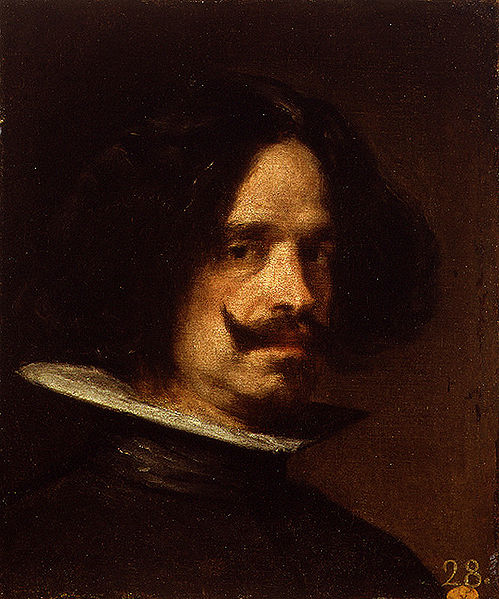 iego
Rodríguez de Silva y Velázquez
( June 6, 1599 – August 6, 1660) was a Spanish painter who was the
leading artist in the court
of King Philip
IV.
He was an individualistic artist of the contemporary Baroque
period, important as a portrait
artist.
In addition to numerous renditions of scenes of historical and
cultural significance, he painted scores of portraits of the Spanish
royal family, other notable European figures, and commoners,
culminating in the production of his masterpiece Las
Meninas
(1656). From the first quarter of the nineteenth century, Velázquez's
artwork was a model for the realist
and impressionist
painters, in particular Édouard
Manet.
Since that time, more modern artists, including Spain's Pablo
Picasso
and Salvador
Dalí,
as well as the Anglo-Irish painter Francis
Bacon,
have paid tribute to Velázquez by recreating several of his most
famous works. Self-portrait
of Diego Velázquez,
iego
Rodríguez de Silva y Velázquez
( June 6, 1599 – August 6, 1660) was a Spanish painter who was the
leading artist in the court
of King Philip
IV.
He was an individualistic artist of the contemporary Baroque
period, important as a portrait
artist.
In addition to numerous renditions of scenes of historical and
cultural significance, he painted scores of portraits of the Spanish
royal family, other notable European figures, and commoners,
culminating in the production of his masterpiece Las
Meninas
(1656). From the first quarter of the nineteenth century, Velázquez's
artwork was a model for the realist
and impressionist
painters, in particular Édouard
Manet.
Since that time, more modern artists, including Spain's Pablo
Picasso
and Salvador
Dalí,
as well as the Anglo-Irish painter Francis
Bacon,
have paid tribute to Velázquez by recreating several of his most
famous works. Self-portrait
of Diego Velázquez,
Born in
Seville,
Andalusia, Spain, Velázquez was educated by his parents to fear God
and, intended for a learned profession, received good training in
languages
and philosophy. Influenced by many artists he showed an early gift
for art; consequently, he began to study under Francisco
de Herrera,
a vigorous painter who disregarded the Italian influence of the early
Seville school. Velázquez remained with him for one year. It was
probably from Herrera that he learned to use brushes with long
bristles.A
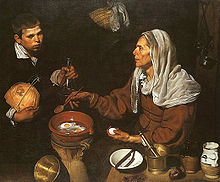 fter
leaving Herrera's studio when he was 12 years old, Velázquez began
to serve as an apprentice under Francisco
Pacheco,
an artist and teacher in Seville. Though considered a generally dull,
undistinguished painter, Pacheco sometimes expressed a simple, direct
realism in contradiction to the style of Raphael
that he was taught. Velázquez remained in Pacheco's school for five
years, studying proportion and perspective and witnessing the trends
in the literary and artistic circles of Seville.
fter
leaving Herrera's studio when he was 12 years old, Velázquez began
to serve as an apprentice under Francisco
Pacheco,
an artist and teacher in Seville. Though considered a generally dull,
undistinguished painter, Pacheco sometimes expressed a simple, direct
realism in contradiction to the style of Raphael
that he was taught. Velázquez remained in Pacheco's school for five
years, studying proportion and perspective and witnessing the trends
in the literary and artistic circles of Seville.
Vieja friendo huevos (1618, English: Old Woman Cooking Eggs). National Gallery of Scotland, Edinburgh.
To Madrid (early period). By the early 1620s, his position and reputation were assured in Seville. Velázquez produced notable works during this time. Known for his compositions of amusing genre scenes (also called bodegónes), such as Old Woman Frying Eggs, his sacred subjects include Adoración de los Reyes (1619, The Adoration of the Magi), and Jesús y los peregrinos de Emaús (1626, Christ and the Pilgrims of Emmaus), both of which begin to express his more pointed and careful realism.
Madrid
and Philip IV. V
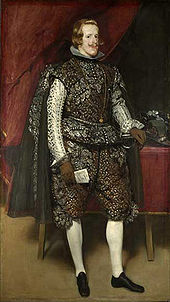
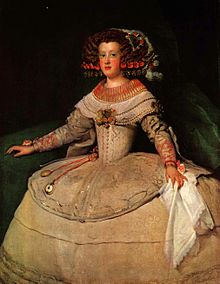 elázquez
went to Madrid
and due to the help of his patrons a portrait of the king was
commissioned to him . On August 16, 1623, Philip IV sat for
Velázquez. Completed in one day, the portrait was likely to have
been no more than a head sketch, but both the king and Olivares were
pleased. Olivares commanded Velázquez to move to Madrid, promising
that no other painter would ever paint Philip's portrait and all
other portraits of the king would be withdrawn from circulation. In
the following year, 1624, he received 300 ducats from the king to pay
the cost of moving his family to Madrid, which became his home for
the remainder of his life.
elázquez
went to Madrid
and due to the help of his patrons a portrait of the king was
commissioned to him . On August 16, 1623, Philip IV sat for
Velázquez. Completed in one day, the portrait was likely to have
been no more than a head sketch, but both the king and Olivares were
pleased. Olivares commanded Velázquez to move to Madrid, promising
that no other painter would ever paint Philip's portrait and all
other portraits of the king would be withdrawn from circulation. In
the following year, 1624, he received 300 ducats from the king to pay
the cost of moving his family to Madrid, which became his home for
the remainder of his life.
Philip IV in Brown and Silver, 1632
Portrait of the Infanta Maria Theresa of Spain, Philip IV's daughter
Through the bust portrait of the king, painted in 1623, Velázquez secured admission to the royal service, with a salary of 20 ducats per month, besides medical attendance, lodgings and payment for the pictures he might paint. The portrait was exhibited on the steps of San Felipe and was received with enthusiasm. It is now lost. The Museo del Prado, however, has two of Velázquez's portraits of the king (nos. 1070 and 1071) in which the severity of the Seville period has disappeared and the tones are more delicate. The modeling is firm, recalling that of Antonio Mor, the Dutch portrait painter of Philip II, who exercised a considerable influence on the Spanish school. In the same year, the Prince of Wales (afterwards Charles I) arrived at the court of Spain. Records indicate that he sat for Velázquez, but the picture is now lost. In September 1628, Peter Paul Rubens came to Madrid as an emissary from the Infanta Isabella, and Velázquez accompanied him to view the Titians at the Escorial. Rubens was then at the height of his powers. The seven months of the diplomatic mission showed Rubens' brilliance as painter and courtier. Rubens had a high opinion of Velázquez, but he had no significant influence on his painting. He reinforced Velázquez's desire to see Italy and the works of the great Italian masters.
In 1627, Philip set a competition for the best painters of Spain with the subject to be the expulsion of the Moors. Velázquez won. His picture was destroyed in a fire at the palace in 1734. Recorded descriptions of it say that it depicted Philip III pointing with his baton to a crowd of men and women being led away by soldiers, while the female personification of Spain sits in calm repose. Velázquez was appointed gentleman usher as reward. Later he also received a daily allowance of 12 réis, the same amount allotted to the court barbers, and 90 ducats a year for dress. Five years after he painted it in 1629, as an extra payment, he received 100 ducats for the picture of Bacchus (The Feast of Bacchus). The spirit and aim of this work are better understood from its Spanish name, Los Borrachos (The Drunks) or Los Bebedores (the drinkers), who are paying mock homage to a half-naked ivy-crowned young man seated on a wine barrel. The painting is firm and solid, and the light and shade are more deftly handled than in former works. Altogether, this production may be taken as the most advanced example of the first style of Velázquez.
Italian period. In 1629, he went to live in Italy for a year and a half. Though his first Italian visit is recognized as a crucial chapter in the development of Velázquez's style – and in the history of Spanish Royal Patronage, since Philip IV sponsored his trip – we know rather little about the details and specifics: what the painter saw, whom he met, how he was perceived and what innovations he hoped to introduce into his painting. It is canonical to divide the artistic career of Velázquez by his two visits to Italy, with his second grouping of works following the first visit and his third grouping following the second visit. This somewhat arbitrary division may be accepted though it will not always apply, because, as is usual in the case of many painters, his styles at times overlap each other. Velázquez rarely signed his pictures, and the royal archives give the dates of only his most important works. Internal evidence and history pertaining to his portraits supply the rest to a certain extent.
Return
to Madrid (middle period). V
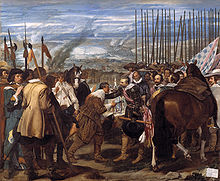 elázquez
then painted the first of many portraits of the young prince and heir
to the Spanish throne, Don Baltasar
Carlos,
looking dignified and lordly even in his childhood, in the dress of a
field marshal on his prancing steed. The scene is in the riding
school
of the palace, the king and queen looking on from a balcony, while
Olivares attends as master of the horse to the prince. Don Baltasar
died in 1646 at the age of seventeen, so, judging by his age in the
portrait, it must have been painted in about 1641.
elázquez
then painted the first of many portraits of the young prince and heir
to the Spanish throne, Don Baltasar
Carlos,
looking dignified and lordly even in his childhood, in the dress of a
field marshal on his prancing steed. The scene is in the riding
school
of the palace, the king and queen looking on from a balcony, while
Olivares attends as master of the horse to the prince. Don Baltasar
died in 1646 at the age of seventeen, so, judging by his age in the
portrait, it must have been painted in about 1641.
La rendición de Breda (1634–1635, English: The Surrender of Breda) was inspired by Velázquez's first visit to Italy, in which he accompanied Ambrogio Spinola, who conquered the Dutch city of Breda a few years prior. This masterwork depicts a transfer of the key to the city from the Dutch to the Spanish army during the Siege of Breda. It is considered one of the best of Velázquez's paintings.
Velázquez was in constant and close attendance on Philip, accompanying him in his journeys to Aragon in 1642 and 1644, and was doubtless present with him when he entered Lerida as a conqueror. It was then that he painted a great equestrian portrait in which the king is represented as a great commander leading his troops—a role which Philip never played except in pageantry. All is full of animation except the stolid face of the king. It hangs as a pendant to the great Olivares portrait—fit rivals of the neighboring Charles V by Titian, which inspired Velázquez to excel himself, and both remarkable for their silvery tone and their feeling of open air.
Portraiture
Besides the
forty portraits of Philip by Velázquez, he painted portraits of
other members of the royal family: Philip's first wife, Elisabeth
of Bourbon,
and her children, especially her eldest son, Don Baltasar Carlos, of
whom there is a beautiful full-length in a private room at Buckingham
Palace.
Cavaliers, soldiers, churchmen, and the poet Francisco
de Quevedo
(now at Apsley
House),
sat for Velázquez. Velázquez also painted several buffoons and
dwarfs in Philip's court, often with respect and sympathetically, as
in The
Favorite
(1644), whose intelligent face and huge folio with ink-bottle and pen
by his side show him to be a wiser and better-educated man than many
of the gallants of the court. Pablo
de Valladolid
(1635), a buffoon evidently acting a part, and The
Buffoon of Coria
(1639) belong to this middle period.The greatest of the religious
paintings by Velázquez also belongs to this middle period, the
Christ
Crucified
(1632). It is a work of tremendous originality, depicting Christ
immediately after death. The Savior's head hangs on his breast and a
mass of dark tangled hair conceals part of the face. The figure
stands alone. T
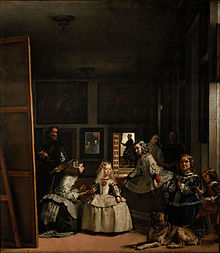 he
picture was lengthened to suit its place in an oratory, but this
addition has since been removed. Some believe that the man in this
painting is his uncle.Philip now entrusted Velázquez with carrying
out a design on which he had long set his heart: the founding of an
academy of art in Spain. Rich in pictures, Spain was weak in
statuary, and Velázquez was commissioned once again to proceed to
Italy to make purchases.
he
picture was lengthened to suit its place in an oratory, but this
addition has since been removed. Some believe that the man in this
painting is his uncle.Philip now entrusted Velázquez with carrying
out a design on which he had long set his heart: the founding of an
academy of art in Spain. Rich in pictures, Spain was weak in
statuary, and Velázquez was commissioned once again to proceed to
Italy to make purchases.
Las Meninas
One of the infantas, Margaret Theresa, the eldest daughter of the new Queen, appears to be subject of Las Meninas (1656, English: The Maids of Honour), Velázquez's magnum opus. However, in looking at the various viewpoints of the painting it is unclear as to who or what is the true subject. Is it the royal daughter, or perhaps the painter himself? The answer may lie in the image on the back wall, depicting the King and Queen. Is this image a mirror, in which case the King and Queen are standing where the spectator stands? Are they the subject of Velazquez's work? Or is the work simply a court painting? Much is still in speculation about the true subject of this masterpiece, and many of the questions that are asked may never be truly answered.
Created four years before his death, it serves as an outstanding example of the European baroque period of art. An apotheosis of the work has been effected since its creation; Luca Giordano, a contemporary Italian painter, referred to it as the "theology of painting", and in the eighteenth century the Englishman Thomas Lawrence cited it as the "philosophy of art", so decidedly capable of producing its desired effect. That effect has been variously interpreted; Dale Brown points out an interpretation that, in inserting within the work a faded portrait of the king and queen hanging on the back wall, Velázquez has ingeniously prognosticated the fall of the Spanish empire that was to gain momentum following his death. Another interpretation is that the portrait is in fact a mirror, and that the painting itself is in the perspective of the King and Queen, hence their reflection can be seen in the mirror on the back wall. It is said the king painted the honorary Cross of Saint James of the Order of Santiago on the breast of the painter as it appears today on the canvas. However, Velázquez did not receive this honor of knighthood until three years after execution of this painting. Even the King of Spain could not make his favorite a belted knight without the consent of the commission established to inquire into the purity of his lineage. The aim of these inquiries would be to prevent the appointment to positions of anyone found to have even a taint of heresy in their lineage—that is, a trace of Jewish or Moorish blood or contamination by trade or commerce in either side of the family for many generations. The records of this commission have been found among the archives of the Order of Santiago. Velázquez was awarded the honor in 1659. His occupation as plebeian and tradesman was justified because, as painter to the king, he was evidently not involved in the practice of "selling" pictures. In the 1966 book Les Mots et Les Choses (The Order of Things), philosopher Michel Foucault devotes the opening chapter to a detailed analysis of Las Meninas. He describes the ways in which the painting problematizes issues of representation through its use of mirrors, screens, and the subsequent oscillations that occur between the image's interior, surface, and exterior. In his book, The Dying Animal, Philip Roth uses Las Meninas as a metaphor for the distracted attraction of courtship.
